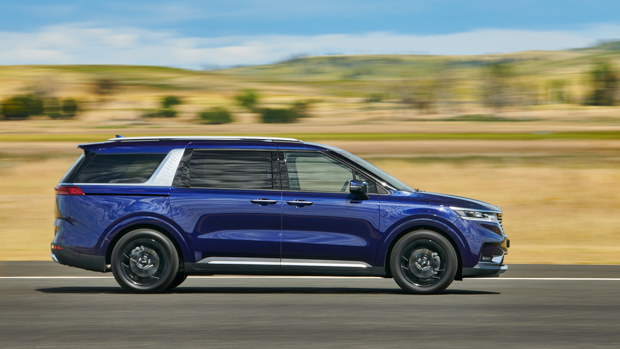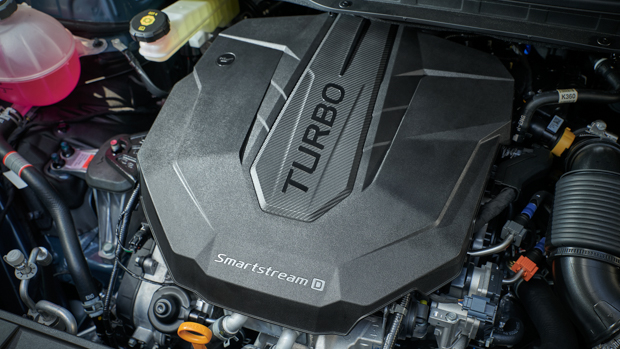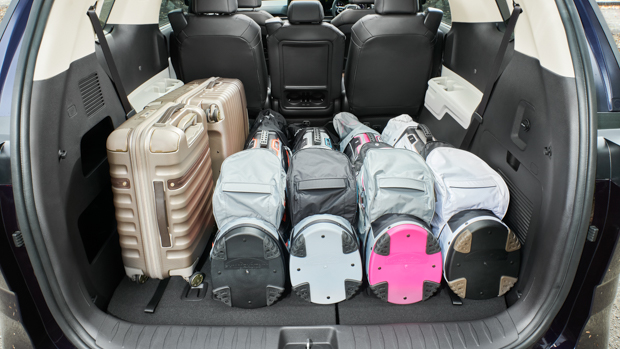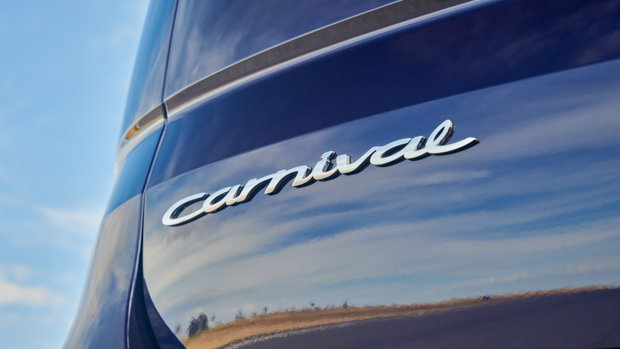-
Car Reviews
- All reviews
- Midsize SUVs
- Small cars
- Utes
- Small SUVs
- Large SUVs
- Large cars
- Sports SUVs
- Sports cars
- Vans
Latest reviews
- Car News
-
Car Comparisons
Latest comparisons
- Chasing Deals
The new Kia Carnival wants to talk family buyers out of purchasing a large SUV – so they’ve amped up the cool factor everywhere you look.

Is a large SUV really the right vehicle for your family – especially if you have a bigger clan?
Possibly not. While SUVs with three rows have offered a more fashionable alternative to vans over the last couple of decades, the once-humble people mover is punching back.
Enter the 2021 Kia Carnival Platinum, which in new fourth-generation form, has been to the gym and muscled up. A cynical eye would say Kia have given the Carnival van SUV-esque styling, and we’d agree. But it works. Pumped guards, front skid plates, way cooler lighting: the new Carnival for 2021 is a van you won’t confuse for a rental car.

But while the Carnival’s exterior design has been given more a few SUV cues, inside, the packaging is just as brilliant as ever. Genuinely spacious over three rows, the Carnival can fit eight people in more comfort than a Mazda CX-9 or even the big, new Hyundai Palisade.
And the trump card of a van like the Carnival is that even when you have all eight seats in play, there is still a huge boot that means those eight folks can travel with their suitcases in tow. Finding an SUV that can take on that task is nigh-on impossible.
So, does the 2021 Kia Carnival finally appeal to both head and heart? Can you love this van? And is the $69,990-driveaway Carnival Platinum range-topper the right vehicle for your family? Let’s find out.
The Kia Carnival has been dominant in the (shrinking) MPV segment in Australia for years. In 2019 and 2020 alike, 55% of van buyers in this country opted for a Carnival. By contrast, just 15% or so went for a Honda Odyssey, and less than ten percent choose a Volkswagen Multivan.
Much of the Carnival’s dominance has been down to its driving dynamics, which in the outgoing third-generation car were quite liveable, with superior suspension comfort to the Odyssey and especially the truck-like Vee-Dubs.
Well, the fourth-generation Carnival blows that benchmark away. Compared to the already-decent outgoing version, the new Carnival is considerably more comfortable to ride in again, and it even offers a bit of verve when driven harder than necessary on a country road.

The Carnival’s impressive dynamics largely come down to Kia’s Australian ride and handling tuning programme that operates out of Melbourne, Victoria.
Kia’s chassis specialist completed a full local tune of the suspension before the Victorian lockdown of 2020, and the result is a compliant, cosseting ride quality that soaks up bumps better than any other people mover we’ve driven.
Usually, in this sort of vehicle, the rear suspension is clumsy and thumps over bumps, especially if it isn’t fully loaded. Not so the 2021 Carnival, which does a brilliant job of smoothing over potholed Australian country roads.

Now, this isn’t a sports car – it’s a relatively soft tune that isn’t characteristic of many other Kias – but for the sort of work a Carnival does, a comfortable suspension that still produces solid body control is the right outcome.
The new Carnival shares its platform with the impressive new Kia Sorento large SUV, which is similarly well-sorted – meaning you can pick the van and still score almost all the attributes that make the Sorento great to drive, with the exception of the steering feel.
What Kia’s Victorian tuners didn’t manage to start before lockdown was a local steering tune, so Australian buyers – for now – are left with the Carnival’s somewhat vague Korean domestic market steering rack. It’s fine, but it is slower and offers less feedback than what this brand typically sticks in its Australian cars.

Kia Australia says that the Carnival will absolutely be receiving a local steering set-up down the line, but they haven’t confirmed if this will be retrofittable to early deliveries. It’s more likely this will be added as a 2022 running change to the car. Would we wait? If you can, sure – but there’s nothing really wrong with the Korean steering tune for now.
We wouldn’t wait because the Carnival can still boogie more than you’d expect on a country road, specific steering feel aside. The Platinum model on test wears black 19-inch wheels shod in quality Continental rubber, and the handling limits of this van are much higher than they need to be.
Under the bonnet, there are two tweaked engines for the 2021 Carnival. On test here is the 2.2-litre turbocharged diesel four-cylinder engine that Kia expects to be the most popular choice.

The ‘Smartstream’ diesel is a development of Kia’s older 2.2-litre unit, but a switch to an aluminium block means it’s a whopping 19kg lighter. Outputs are familiar, at 148kW of power and 440Nm of torque – more than enough muscularity to haul the Carnival and eight people aboard while delivering real fuel economy of about 9L/100km.
For $2,000 less, you can opt for a 3.5-litre naturally aspirated V6 petrol engine. Grunty and good to listen to, the petrol makes 216kW of power and 355Nm of torque – but you have to rev it right out to make those figures, unlike the torquey turbo diesel. That means fuel economy will be worse in the real world, and the price savings will be negated long-term.
Both the petrol and diesel funnel power to the front wheels only, through a slick and unobtrusive eight-speed torque converter automatic transmission. The lack of optional AWD is disappointing, given it’s offered on the Sorento with which the Carnival shares so many components. Kia say AWD isn’t in development for the van at all.

What’s impressive is how much safety technology is packed in to the Carnival. Standard on every grade, from the $50,030-driveaway S petrol, are autonomous emergency braking with car, pedestrian, cyclist and junction braking, lane tracing, adaptive cruise control, blind spot monitoring with rear cross-traffic alert, speed sign recognition, and driver fatigue detection.
The upper-mid grade SLi (from $60,290 driveaway) goes further, adding in rear cross-traffic AEB and safe exit alert, which warns if a pedestrian or cyclist is about to pass the car when you attempt to open a door. In fact, safe exit momentarily prevents the electric sliding door of the SLi and Platinum grades from opening onto a cyclist.
Reversing AEB is not available on the Carnival. Reversing AEB can autonomously apply the brakes if you are about to reverse into an object or person.
The Carnival’s interior is an even nicer place to be this time around, combining an SUV-like front cabin with all the benefits of a van in the two spacious rows behind.
Up front, every grade bar the base ‘S’ get an impressively wide and crisp 12.3-inch touchscreen in the centre, which runs integrated satellite navigation, DAB digital radio, and on the SLi and Platinum, a 360-degree parking camera that makes this bus easier to manoeuvre at low speed.
While there is a wireless phone charger, only the base model gets wireless Apple CarPlay and Android Auto due to a dispute between the Hyundai/Kia group and one of the tech giants. On the other variants, including the Platinum, you have to plug in via a USB-A cable.

At least music sounds great from the Platinum’s 12-speaker Bose stereo, and on the whole, Kia’s own infotainment system is logical and intuitive. There are physical buttons for common climate and audio controls, too, which helps. Some of these are touch-sensitive piano black switches, however, which smudge.
All Carnival grades currently sport conventional analogue gauges with a small digital speedometer and trip computer in between them. High-spec Carnivals are meant to have a further 12-inch digital driver display, as seen on the new Kia Sorento and Hyundai Santa Fe: Kia says this was another casualty of COVID-19 and it will be added later.
It’s a shame, because the most useful feature of the digital dashboard on those cars is the incredibly intuitive blind spot cameras, that momentarily convert the speedo or tacho to left or right cameras showing your blind spot. It’s a terrific feature that is much better than traditional blind spot sonar monitoring. The Carnival will get this later in Australia.

The Platinum is available with only one interior combination: dark grey artificial leather with cream accents on the armrest, dash and doors. Thankfully, the seats are heated and cooled, meaning the upholstery stays temperate. The front seat squabs are too short, though: long-legged drivers will ache for more support.
Of course, being a van, the Carnival is all about the second and third rows. These spaces are quite customisable, with seats sliding and reclining individually. You can remove the middle seat in the middle row, creating a very convenient, adult-sized walkway to the rear row.
Or you can turn that seat 180-degrees: Kia momentarily spruiked this as a way to place a baby facing a parent seated in the outboard seats, before notifying journalists that there is no rear-facing middle baby seat homologated for Australia, and discouraging the practice.

Still, all grades have air conditioning vents – and airbags – stretching right to the third row. And the space on offer to at least five people in the back is quite palatial: most of all in the second row, but also in the outboard third row seats. An abundance of USB charge points and cupholders helps. Only the way-back middle-seat is a less comfortable perch.
Of course, the fact the Carnival has dual sliding doors – which are electrically-powered in the SLi and Platinum grades – helps enormously with getting kids in and out. The wide apertures make loading the Kia easy, and of course, door dings are far less likely. The new model even lets you stand next to the sliding doors, hands full, key in pocket – and they open automatically.
Boot space is also immense. Even with all three rows in place, the Carnival offers a huge 627 litres of boot space – up from 359 litres on the old version thanks to a longer rear overhang. Nice work. Fold the third row and the Carnival gives you 2,785 litres of space in five-seat mode. A power tailgate is standard at this level and you can programme the opening height.

One of the biggest benefits of a Kia is that the brand has a seven year, unlimited kilometre warranty in Australia – and the new Carnival is covered by this. That’s a longer warranty that most rival brands: Hyundai and Mazda, for example, offer five years of coverage.
You also get seven years of roadside assistance thrown in, which gives you added peace of mind.
Kia also offer seven years of capped price servicing for the Carnival. With the diesel engine, the Carnival requires servicing every 12 months or 15,000 kilometres – whichever comes first.

Kia are still finalising service pricing for the new Carnival, but the brand have advised us that the servicing charges won’t be drastically different to the outgoing version. In diesel form, that van cost $2,510 to service for the first five years or 75,000 kilometres, with the only big ‘shock’ coming at the significant fourth year service, which cost $710.
By contrast, the Honda Odyssey needs servicing every six months or 10,000 kilometres, which is less convenient. The Honda is also more expensive to maintain, costing $2,993 over five years (but a longer 100,000 kilometres).
On the fuel consumption front, the Carnival diesel is impressively frugal for a big van, drinking about 9L/100km in the real world, while Kia claims 6.5L/100km in ideal conditions.
The Kia Carnival makes a lot of sense for big families.
And for big families that want to ride in style, with an impressive smattering of convenience and safety technology, plus surprise-and-delight features like autonomous power doors and a huge, deep boot, the Carnival Platinum seems like a lot of car for under $70,000 on-the-road.
Still, the Carnival SLi offers most of that kit for even less coin, so we’d consider both versions. And if features like a digital dashboard with its blind spot cameras, or an Australian-specific steering tune, are high on your list, you’ll need to wait longer. The Carnival will score this kit, probably later this year.
Still, if you have a realistic need to seat seven adults or lots of tall teenagers on a regular basis, there’s no beating a van. And among vans, there’s no beating the new Kia Carnival.
Variant tested PLATINUM
Key specs (as tested)
About Chasing cars
Chasing Cars reviews are 100% independent.
Because we are powered by Budget Direct Insurance, we don’t receive advertising or sales revenue from car manufacturers.
We’re truly independent – giving you Australia’s best car reviews.
The estimate provided does not take into account your personal circumstances but is intended to give a general indication of the cost of insurance, in order to obtain a complete quote, please visit www.budgetdirect.com.au. Estimate includes 15%^ online discount.
^Conditions Apply
Budget Direct Insurance arranged by Auto & General Services Pty Ltd ACN 003 617 909(AGS) AFSL 241 411, for and on behalf of the insurer, Auto & General Insurance Company Limited(ABN 42 111 586 353, AFSL 285 571).Because we don’t know your financial needs, we can’t advise you if this insurance will suit you. You should consider your needs and the Product Disclosure Statement before making a decision to buy insurance. Terms and conditions apply.
Indicative quote based on assumptions including postcode , 40 year old male with no offences, licence suspensions or claims in the last 5 years, a NCD Rating 1 and no younger drivers listed. White car, driven up to 10,000kms a year, unfinanced, with no modifications, factory options and/or non-standard accessories, private use only and garaged at night.
^Online Discounts Terms & Conditions
1. Discounts apply to the premium paid for a new Budget Direct Gold Comprehensive Car Insurance, Third Party Property Only or Third Party Property, Fire & Theft Insurance policy initiated online on or after 29 March 2017. Discounts do not apply to optional Roadside Assistance.
2. Discounts do not apply to any renewal offer of insurance.
3. Discounts only apply to the insurance portion of the premium. Discounts are applied before government charges, taxes, levies and fees, including instalment processing fees (as applicable). The full extent of discounts may therefore be impacted.
4. We reserve the right to change the offer without notice.